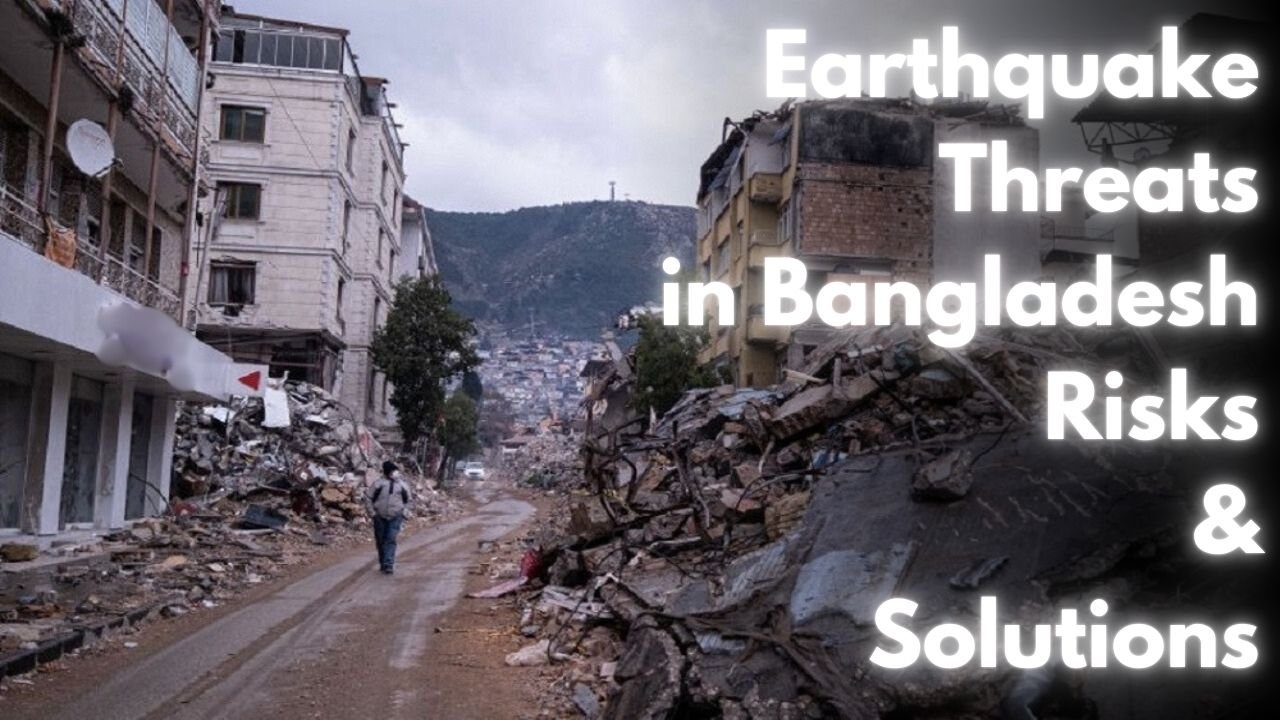Bangladesh Earthquake Risks: Urgent Steps for Safer Future

Earthquakes and Bangladesh: Understanding the Risks and Building a Safer Future
Bangladesh, a nation of over 170 million people, is precariously perched at the intersection of active tectonic plates, making it one of the most earthquake-prone regions in the world. Recent seismic activities, including multiple tremors in January 2025, have highlighted the urgency for disaster preparedness and infrastructure resilience. As the country’s dense population and vulnerable infrastructure amplify the risks, experts and policymakers are calling for immediate action to mitigate the potential devastation of a major earthquake. This article provides a comprehensive overview of Bangladesh’s seismic risks, recent events, and the steps needed to ensure a safer future.
Bangladesh: A Nation on the Edge of Seismic Risk
Nestled at the junction of the Indian and Eurasian tectonic plates, Bangladesh faces significant seismic threats due to its geographical location. The country is crisscrossed by active fault lines, including the Dauki Fault, the Madhupur Fault, and the Shillong Plateau, which have historically triggered devastating earthquakes. Between 1869 and 1930, five major earthquakes with magnitudes exceeding 7.0 struck the region, leaving behind trails of destruction. Since then, a relative lull in high-magnitude quakes has raised concerns that the region is overdue for a major seismic event.
Recent data shows a sharp rise in earthquakes in Bangladesh. Since 2024, over 60 earthquakes have been recorded. Of these, three exceeded a magnitude of 4.0. Experts believe this increase may signal the possibility of a major quake.
January 2025: A Month of Tremors
January 3, 2025
A moderate earthquake, 482 kilometers from Dhaka, shook parts of Bangladesh. While it caused no damage, it highlighted the region’s vulnerability.
January 7, 2025
A strong 7.1-magnitude quake rattled South Asia. It affected Nepal, India, Bhutan, and China. Bangladesh escaped casualties but felt the tremor’s impact.
January 21, 2025
A 4.1-magnitude earthquake struck Khasi Hills, Meghalaya, India. Its effects were felt across the border in Bangladesh.
January 24, 2025
Another quake, measuring 5.1, hit Wazin, Manipur, India. The tremors reached Dhaka, causing panic among residents.
These frequent quakes underline the need for better preparedness. Improved infrastructure and disaster response systems are essential to minimize risks. The rising activity is a wake-up call for proactive measures.
Dhaka: A City at Extreme Risk
Dhaka, Bangladesh’s capital and one of the world’s most densely populated cities, ranks among the top 20 most vulnerable urban centers to earthquakes. The city’s risk is exacerbated by:
- Weak Infrastructure: A 2018 survey revealed that many buildings in Mirpur, Mohammadpur, Pallabi, Rampura, Motijheel, and Khilgaon fail to meet basic structural and design standards. The 2013 Rana Plaza collapse, which claimed over 1,100 lives, serves as a tragic example of the consequences of poorly constructed buildings.
- Unplanned Urbanization: Rapid and unregulated urban growth has resulted in densely populated neighborhoods with limited open spaces, complicating evacuation and rescue efforts during disasters.
- High Population Density: With over 20 million residents, Dhaka’s crowded conditions make it particularly susceptible to large-scale casualties and infrastructure collapse during a major earthquake.
Other High-Risk Regions in Bangladesh
Beyond Dhaka, several regions face heightened earthquake risks:
- Chittagong and the Chittagong Hill Tracts: These areas are located near tectonic plate boundaries and have a history of seismic activity.
- Sylhet’s Jaintiapur Region: Identified as an extreme risk zone, a high-magnitude earthquake here could have devastating effects on the region and beyond.
- Khasi Hills and Shillong Plateau: Frequent seismic activities in these regions impact both Bangladesh and its neighboring countries.
Bangladesh’s Preparedness Challenges
Despite the growing threat, Bangladesh’s preparedness for a major earthquake remains inadequate. Several challenges hinder the country’s ability to effectively mitigate and respond to seismic disasters:
- Fragile Infrastructure: Hospitals, emergency response centers, and government offices are among the critical facilities requiring urgent retrofitting to withstand seismic shocks.
- Weak Enforcement of Building Codes: While building codes exist, their enforcement is often lax, leading to substandard construction that cannot endure significant tremors.
- Public Awareness Deficit: Many citizens lack knowledge of emergency protocols, evacuation procedures, and basic earthquake safety measures, leaving them vulnerable during disasters.
- Resource Constraints: Limited financial and technical resources hinder large-scale retrofitting projects and disaster preparedness initiatives.

Steps Toward Mitigation and Resilience
Recognizing the urgent need to address these challenges, the government and international organizations have taken several steps to enhance Bangladesh’s earthquake preparedness:
- Sub-National Earthquake Risk Assessment
In March 2024, the Ministry of Disaster Management and Relief (MoDMR), in collaboration with the UN Office for Disaster Risk Reduction (UNDRR) and the Global Earthquake Model (GEM) Foundation, launched Bangladesh’s first sub-national earthquake risk assessment. This initiative aims to identify vulnerabilities and recommend actionable strategies through advanced seismic hazard modeling, building exposure analyses, and fragility evaluations.
Key findings from the assessment include:
- Critical Infrastructure Vulnerabilities: Hospitals, schools, and government buildings were found to be particularly at risk.
- Urban Planning Gaps: Poor enforcement of building codes and rapid urbanization are major contributors to the country’s seismic risks.
- Public Awareness Gaps: Limited understanding of earthquake preparedness among citizens highlights the need for widespread education campaigns.
- Capacity Building and Training
During the dissemination of the sub-national assessment findings, 35 university students received technical training on earthquake modeling and disaster management. This effort aims to equip the next generation with the skills needed to address seismic challenges.
- Retrofitting Projects
Experts recommend prioritizing the retrofitting of critical infrastructure, such as hospitals and emergency response centers, to enhance their resilience against earthquakes.
- Public Awareness Campaigns
Raising awareness about earthquake preparedness is crucial for reducing casualties during disasters. Educational initiatives should focus on teaching citizens how to respond during an earthquake, including evacuation procedures and safety measures.
- Strengthening Building Codes
Enforcing and updating building codes to reflect international standards is essential for ensuring the construction of earthquake-resistant structures. Regular inspections and penalties for non-compliance can help improve adherence to these codes.
- Enhancing Disaster Response Coordination
Improved coordination between civil and military agencies is vital for efficient disaster response. Joint training exercises and contingency planning can ensure a swift and effective response to future earthquakes.
The Role of Regional Cooperation
Given the transboundary nature of seismic risks, regional cooperation is essential for effective disaster management. Collaborative efforts among South Asian nations can include:
- Sharing Seismic Data: Enhanced data sharing can improve early warning systems and help countries prepare for potential disasters.
- Joint Training Programs: Cross-border training initiatives can strengthen the disaster response capabilities of neighboring nations.
- Regional Funding Mechanisms: Establishing a shared fund for disaster preparedness can support infrastructure retrofitting and other mitigation projects.
A Call to Action
Bangladesh’s position at the collision zone of tectonic plates makes it inherently vulnerable to earthquakes. The repeated tremors in January 2025 are a stark reminder of the urgent need for action. While initiatives such as the sub-national earthquake risk assessment mark important steps forward, more must be done to address the country’s seismic vulnerabilities.
Strengthening building codes, retrofitting critical infrastructure, raising public awareness, and enhancing disaster response coordination are key priorities. Additionally, fostering regional cooperation can help South Asia as a whole become more resilient to seismic disasters.
Bangladesh stands at a crossroads. By transforming its vulnerabilities into a robust defense against earthquakes, the nation can safeguard millions of lives and pave the way for a safer future. The time to act is now.







